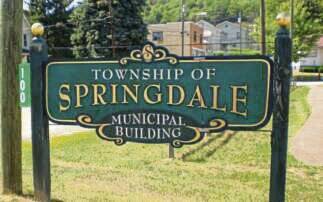Springdale aims to address infrastructure by drafting 5-year plans
Getting a handle on infrastructure status and needs appears to be a major priority for the Springdale Township commissioners.
The commissioners, during their meeting Thursday, Feb. 24, said they have asked township engineer, Sean Naylor of Senate Engineering, to provide a proposal on formulating three 5-year plans. Areas of the infrastructure that the plans would address are water, sewage and roads.
“There are some real pointed issues we are facing,” said Commissioner Tim Basilone.
“We don’t have our information all mapped up,” he said. “We need to look at mapping and what we have.”
For example, Basilone mentioned an issue with water service.
The township does not have its own water supply and has to purchase water from surrounding communities.
It budgeted $225,000 for water purchases in 2021, and this year, it has allocated $181,000 for water.
According to Basilone, however, the township is not getting its money’s worth because of “line loss.”
“We are using only 50 percent of the water we are purchasing,” he said.
“What that says is we have a line leak that is doubling our water consumption.”
“That’s a lot of money that we could turn over and pave roads with,” Basilone said.
He and Naylor said the goal of the 5-year plan is to digitally map where the water lines are and what type of pipe is being used in order to isolate and repair such leaks and replace old water lines with those made of more modern materials.
Naylor said a lot of the water lines in the township are made of an asbestos concrete, which tends to become brittle and break easily.
“The goal would be to identify what lines are asbestos concrete pipe and those would go to the top of the (priority) list,” Naylor said.
Naylor said the objective is to reduce the water loss to 20% or less, which is about average in water systems.
A similar situation exists with sewage lines, except the problem isn’t wastewater leaking from the lines but stormwater infiltrating into them.
That can create a heavier sewage flow from the township into the Allegheny Valley Joint Sewage Authority treatment plant in Harmar, resulting in higher sewage treatment costs for the township.
“One of the strategies that would be part of this five-year plan is determining what areas we have this excess flow of water in,” Naylor said.
Another matter that digital mapping will address is keeping track of where repairs are made. Naylor said in the past the public works department might come across a small line leak or a malfunctioning valve and simply make the repair before moving on to the next task.
As a result, he and Senate were not always aware of that work which could affect planning for other projects.
By inputting those repairs and when they were made on a digital map, Naylor said it presents a clearer, more accurate picture of what is needed when planning for a broader project.
Planning for road projects is no different.
“It’s pretty much the same thing, figuring out problem areas and strategizing,” Naylor said.
Remove the ads from your TribLIVE reading experience but still support the journalists who create the content with TribLIVE Ad-Free.

